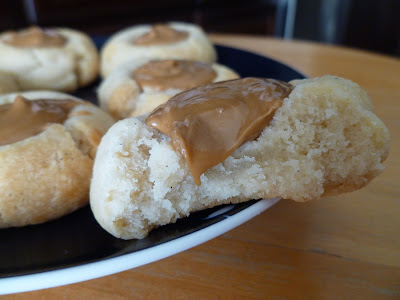Lemon Swig Sugar Cookies - made dough May 13, 2017 from
The Recipe Critic
I don’t know if Swig Sugar Cookies are more popular or
well known in other parts of the country but they’re not that common where I
live. I only heard about them through the internet and since I don’t buy store
bought cookies (Oreos and Biscoff cookies being the rare exceptions), if
they’re sold in the supermarkets in my area, I’ve missed them completely.
So it’s just as well that I’m a cookie snob and prefer to
make my own anyway. If you’ve never had a “swig sugar cookie”, they’re best
described as a cross between a cakey shortbread and a sugar cookie. Every recipe I’ve seen makes them large and
they’re frosted with some kind of vanilla frosting (not a glaze or a thin icing
but an honest to goodness frosting) which can easily be tinted different
colors, depending on your preference, mood or occasion. Or you can leave
untinted and flavor it instead.
Which is what this version does in making a lemon cream
cheese frosting for the cookies. The dough itself is easy to make and great to
work with, having a smooth consistency, not dry or crumbly or oily or sticky.
Make the dough balls into the size of a golf ball – or thereabouts – then press
gently with the bottom of a glass. Not too hard as you don’t want them to be
thin and they will spread a little, though not much.


I erred on the side of caution and only pressed so that the top dome of the dough ball was flat and I was left with a thick, chubby disk. Which I then froze overnight. When it came time to bake them, they spread slightly and when I took them out, I dipped the bottom of the glass in granulated sugar and pressed more firmly. You want to get those iconic “edges” to the cookie that comes with all that bottom-of-glass pressing. Plus a very slight indent or well to better hold the frosting. You only want to frost the center of the cookie and leave a ring of outer edge unfrosted and exposed. That makes for easier handling. Plus it’s prettier.



I really enjoyed these cookies. And when I say “enjoyed” and “cookies”, I meant I ate three. Three big cookies. Spaced out over 24 hours but still…. That’s two cookies above my usual taste test ration. So you know I can sincerely tell you these were great cookies. If you’re a vanilla fan or one of those people who “don’t do chocolate” or have nut allergies or simply have a pulse, these are delicious cookies to try out.
If you’re making these for a crowd and don’t want to have
such big servings, rather than making them smaller, which I think detracts from
the bold-as-brass, look-at-me impression you want them to make, go ahead and
make them jumbo or large-sized but cut them in half after you frost them. Then
serve with the halves lined up to still look like whole cookies. People can
take then take a half as their serving. But after they take a bite, I bet you
they come back for the other half.
1 cup butter, room temperature
3/4 cup vegetable oil
1 1/4 cup granulated sugar plus 1/4 cup reserved
3/4 cup confectioners' sugar
2 tablespoons water
1 teaspoon lemon juice
1 tablespoon lemon zest
2 large eggs
1/2 teaspoon baking soda
1/2 teaspoon cream of tartar
1 teaspoon salt
5 1/2 cups flour
Lemon Cream Cheese Frosting
1 8-ounce package cream cheese, softened
1/4 cup butter, room temperature
2 tablespoons lemon juice
2 teaspoons lemon zest
1 teaspoon vanilla extract
5 cups confectioners' sugar (or less if you prefer less sweet and more tangy frosting)
- Preheat oven to 350 degrees F. Line baking sheets with parchment paper.
- In a medium-sized mixing bowl, combine flour, baking soda, cream of tartar and salt; set aside.
- In a large mixing bowl, cream together butter, vegetable oil, 1 1/4 cups granulated sugar, confectioners' sugar and water. Add in lemon juice and lemon zest and mix briefly to combine. Add eggs and beat until just combined.
- Slowly add in flour mixture until just combined. Do not overmix. Roll the dough into golf-ball sized balls and place onto prepared baking sheets.
- Dip the bottom of a glass into the reserved 1/4 cup sugar and press onto each dough ball to slightly flatten the cookie.
- Bake for 8-10 minutes or until the bottoms are lightly brown. Do not overbake. Remove to wire cooling rack and let cool completely before frosting.
- To make the frosting: beat cream cheese and butter until creamy and well combined. Add lemon juice, lemon zest and vanilla and beat until incorporated. Add confectioners' sugar, one cup at a time, until desired flavor and consistency. Beat until smooth and frost each cookie with frosting.



















































